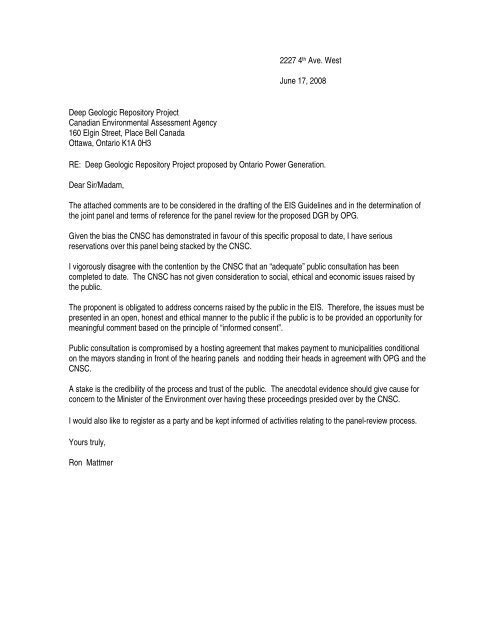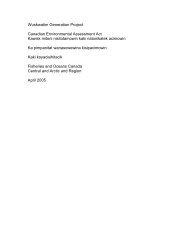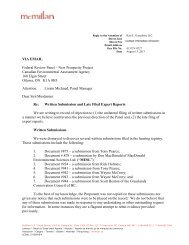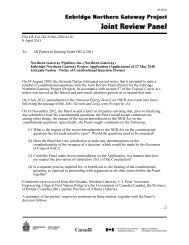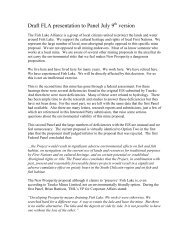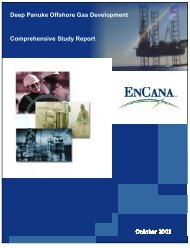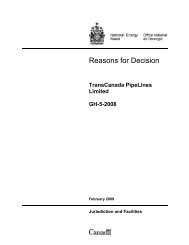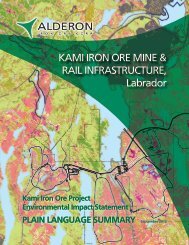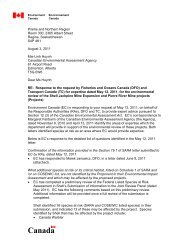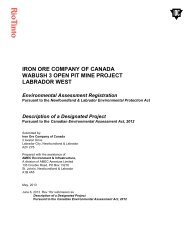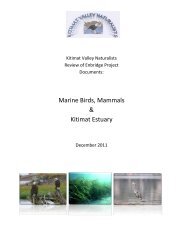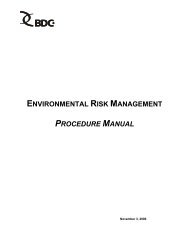Comment on EIS guidelines (From Ron Mattmer to CEAA)
Comment on EIS guidelines (From Ron Mattmer to CEAA)
Comment on EIS guidelines (From Ron Mattmer to CEAA)
You also want an ePaper? Increase the reach of your titles
YUMPU automatically turns print PDFs into web optimized ePapers that Google loves.
2227 4 th Ave. West<br />
June 17, 2008<br />
Deep Geologic Reposi<strong>to</strong>ry Project<br />
Canadian Envir<strong>on</strong>mental Assessment Agency<br />
160 Elgin Street, Place Bell Canada<br />
Ottawa, Ontario K1A 0H3<br />
RE: Deep Geologic Reposi<strong>to</strong>ry Project proposed by Ontario Power Generati<strong>on</strong>.<br />
Dear Sir/Madam,<br />
The attached comments are <strong>to</strong> be c<strong>on</strong>sidered in the drafting of the <strong>EIS</strong> Guidelines and in the determinati<strong>on</strong> of<br />
the joint panel and terms of reference for the panel review for the proposed DGR by OPG.<br />
Given the bias the CNSC has dem<strong>on</strong>strated in favour of this specific proposal <strong>to</strong> date, I have serious<br />
reservati<strong>on</strong>s over this panel being stacked by the CNSC.<br />
I vigorously disagree with the c<strong>on</strong>tenti<strong>on</strong> by the CNSC that an “adequate” public c<strong>on</strong>sultati<strong>on</strong> has been<br />
completed <strong>to</strong> date. The CNSC has not given c<strong>on</strong>siderati<strong>on</strong> <strong>to</strong> social, ethical and ec<strong>on</strong>omic issues raised by<br />
the public.<br />
The prop<strong>on</strong>ent is obligated <strong>to</strong> address c<strong>on</strong>cerns raised by the public in the <strong>EIS</strong>. Therefore, the issues must be<br />
presented in an open, h<strong>on</strong>est and ethical manner <strong>to</strong> the public if the public is <strong>to</strong> be provided an opportunity for<br />
meaningful comment based <strong>on</strong> the principle of “informed c<strong>on</strong>sent”.<br />
Public c<strong>on</strong>sultati<strong>on</strong> is compromised by a hosting agreement that makes payment <strong>to</strong> municipalities c<strong>on</strong>diti<strong>on</strong>al<br />
<strong>on</strong> the mayors standing in fr<strong>on</strong>t of the hearing panels and nodding their heads in agreement with OPG and the<br />
CNSC.<br />
A stake is the credibility of the process and trust of the public. The anecdotal evidence should give cause for<br />
c<strong>on</strong>cern <strong>to</strong> the Minister of the Envir<strong>on</strong>ment over having these proceedings presided over by the CNSC.<br />
I would also like <strong>to</strong> register as a party and be kept informed of activities relating <strong>to</strong> the panel-review process.<br />
Yours truly,<br />
R<strong>on</strong> <strong>Mattmer</strong>
Attachment- submissi<strong>on</strong> by R. <strong>Mattmer</strong> re. Draft <strong>EIS</strong> Guidelines and JPR Agreement for the Deep Geologic<br />
Reposi<strong>to</strong>ry Project proposed by Ontario Power Generati<strong>on</strong>.<br />
Background<br />
In the absence of an over-all policy and co-ordinated plan for the disposal of Canada’s low level and<br />
intermediate level nuclear waste, Ontario Power Generati<strong>on</strong> (OPG) proposes <strong>to</strong> spend close <strong>to</strong> $1 billi<strong>on</strong> <strong>on</strong> a<br />
Deep Ground Reposi<strong>to</strong>ry (DGR). For its advocacy <strong>on</strong> behalf of the project, the municipality Kincardine will be<br />
paid over $20 milli<strong>on</strong><br />
In 2002, the municipal corporati<strong>on</strong> of Kincardine made its support for the license renewal of OPG’s waste<br />
facility at the Bruce site c<strong>on</strong>diti<strong>on</strong>al <strong>on</strong> OPG entering in<strong>to</strong> an agreement with the municipal corporati<strong>on</strong>.<br />
“On the understanding that the above memorandum of understanding is in place by the hearing date, we<br />
will support a n<strong>on</strong>-transferable five-year license renewal, with a review in two years <strong>to</strong> evaluate the<br />
progress of the negotiati<strong>on</strong>s.<br />
It is from this important symbiotic relati<strong>on</strong>ship that the needs of both industry and the public interest can<br />
work <strong>to</strong>gether <strong>to</strong> forge a str<strong>on</strong>g relati<strong>on</strong>ship that is both healthy and safe for the Canadian public.”<br />
Mayor of Kincardine - oral submissi<strong>on</strong> <strong>to</strong> the Commissi<strong>on</strong> WWMF license renewal hearing -2002<br />
OPG appears <strong>to</strong> have been a willing participant in this scheme <strong>to</strong> force the hand of the Federal and Provincial<br />
governments.<br />
“We have had discussi<strong>on</strong>s [with municipality] over the last six, seven, eight m<strong>on</strong>ths which have dovetailed<br />
in some respects with the relicensing of the Western Waste Management Facility. I say dovetailed,<br />
because it could be in part a coincidence; it could be in another part a nice coincidence of mutual<br />
interests coming <strong>to</strong>gether.<br />
We have always wanted <strong>to</strong> address the issue of low and intermediate waste in a more systematic basis.<br />
We have a reference plan for financial purposes. We have always wanted <strong>to</strong> move <strong>to</strong> the next step in<br />
terms of what do we do <strong>on</strong>ce the high level waste has been dealt with, which we believe from a process<br />
perspective, as a result of C-27, is <strong>on</strong> the way. It was good timing for us and the municipality”.<br />
Richard Dicerni, Ontario Power Generati<strong>on</strong>- WWMF license renewal hearing -2002<br />
OPG, the municipal corporati<strong>on</strong> of Kincardine and the CNSC have developed an intimate working relati<strong>on</strong>ship<br />
<strong>to</strong> further the proposal for their mutual benefit. The Municipal Corporati<strong>on</strong> of Kincardine passed a moti<strong>on</strong><br />
“expressing its c<strong>on</strong>cerns about political interference in the Canadian Nuclear Safety Commissi<strong>on</strong>” by the<br />
federal government. The moti<strong>on</strong>, which passed unanimously, urges the federal government not <strong>to</strong> meddle in<br />
the independence of the commissi<strong>on</strong>.<br />
Council "urges the Federal Minister of Natural Resources and the Government of Canada <strong>to</strong> assess and<br />
c<strong>on</strong>sider the role of the CNSC in protecting the citizens of Kincardine and c<strong>on</strong>firm that the Canadian<br />
Nuclear Safety Commissi<strong>on</strong> is an independent body and it's <strong>on</strong>ly through this independence can the<br />
CNSC ensure the public's safety," the resoluti<strong>on</strong> says.<br />
The recent demoti<strong>on</strong> of CNSC president Linda Keen by federal Natural Resources Minister Gary Lunn<br />
"may alter the percepti<strong>on</strong> of the role of the CNSC" and its independence in exercising its activities.
OPG's proposed deep geologic reposi<strong>to</strong>ry projects will require a licence from the CNSC and "the<br />
c<strong>on</strong>fidence of the community regarding these proposed developments will be based, in part, <strong>on</strong> the fact<br />
the CNSC is resp<strong>on</strong>sible for ensuring the safety of these facilities regardless of political climate or will," the<br />
moti<strong>on</strong> says.<br />
Mayor Larry Kraemer said he will bring the moti<strong>on</strong> <strong>to</strong> Bruce County council <strong>to</strong> ask for its endorsement<br />
and <strong>to</strong> the Canadian Associati<strong>on</strong> of Nuclear Host Communities meeting at the end of February.”<br />
A councillor also suggested it also be forwarded <strong>to</strong> Hur<strong>on</strong>-Bruce MPP Carol Mitchell (Lib) and MP Paul<br />
Steckle (Lib).<br />
Owen Sound Sun Times, January 29, 2008 -Council c<strong>on</strong>cerned about Ottawa meddling in nuclear safety<br />
Canadian Envir<strong>on</strong>mental Assessment Act<br />
The proposed project is subject <strong>to</strong> the Canadian Envir<strong>on</strong>mental Assessment Act (<strong>CEAA</strong>). The <strong>CEAA</strong> provides<br />
for the public <strong>to</strong> be c<strong>on</strong>sulted when determining the fac<strong>to</strong>rs that are <strong>to</strong> be included in the assessment and how<br />
the assessment is <strong>to</strong> be c<strong>on</strong>ducted, i.e., as a comprehensive study under the purview of the CNSC or as an<br />
independent panel review.<br />
The criteria for referring the proposal <strong>to</strong> an independent review panel are:<br />
• the project is likely <strong>to</strong> cause significant adverse envir<strong>on</strong>mental effects,<br />
• it is uncertain whether the project is likely <strong>to</strong> cause significant adverse envir<strong>on</strong>mental effects, or<br />
• public c<strong>on</strong>cerns warrant referral.<br />
The CNSC had performed a preliminary assessment and c<strong>on</strong>cluded that the project is not likely <strong>to</strong> cause<br />
significant adverse envir<strong>on</strong>mental effects, that it is also unlikely that such a c<strong>on</strong>clusi<strong>on</strong> would be uncertain and<br />
that public c<strong>on</strong>cerns do not warrant a referral <strong>to</strong> a review panel.<br />
Policy Framework<br />
The federal government has resp<strong>on</strong>sibility <strong>to</strong> develop overall policy and strategy for radioactive waste<br />
management.<br />
“Canada does not have an approved disposal technology or any disposal sites for its LLW. It has not yet<br />
determined what will be needed in the way of disposal services and facilities. In additi<strong>on</strong>, there is no coordinated<br />
plan or timetable for disposing of Canada's operati<strong>on</strong>al LLW.<br />
-Audi<strong>to</strong>r General Report 1995<br />
The “AECL c<strong>on</strong>cept” for the disposal of nuclear fuel waste had been reviewed by the Seaborn panel. The<br />
panel emphasized the need for a comprehensive plan for c<strong>on</strong>sulting Canadians broadly. The federal<br />
government resp<strong>on</strong>ded <strong>to</strong> the Seaborn Panel Report with the Nuclear Fuel Waste Act and the creati<strong>on</strong> of the<br />
Nuclear Waste Management Organizati<strong>on</strong>.<br />
Perhaps the most fundamental element of a strategy for l<strong>on</strong>g-term management of nuclear waste is a<br />
nati<strong>on</strong>al policy that assigns appropriate accountabilities. Here in Canada, that was d<strong>on</strong>e in 1996 when the<br />
Minister of Natural Resource established a policy framework for radioactive waste management. This<br />
clearly states the Federal government will be resp<strong>on</strong>sible for policy, oversight and regulati<strong>on</strong> and the<br />
waste owners resp<strong>on</strong>sible for funding and management of wastes, including permanent disposal.”<br />
-Ken Nash, Vice Pres. OPG & Chair NW M O, Canadian Nuclear Associati<strong>on</strong> Seminar February 2006
The Nuclear Waste Management Organizati<strong>on</strong> was created <strong>to</strong> develop an approach for dealing with Canada’s<br />
used reac<strong>to</strong>r fuel. After years of study and public c<strong>on</strong>sultati<strong>on</strong>s, the NWMO decided <strong>on</strong> an adaptive phased<br />
management approach <strong>to</strong> managing the used fuel. Under this approach, a centralized DGR would NOT be<br />
sited for another 60 years.<br />
Guiding Values and Principles<br />
The NWMO acknowledged that public engagement should be based <strong>on</strong> principles of openness, transparency,<br />
integrity and mutual respect. Engagement should ensure that those who most directly could be exposed <strong>to</strong><br />
harm or risk of harm are informed of the potential risks and equipped with resources <strong>to</strong> participate in<br />
discussi<strong>on</strong>s and decisi<strong>on</strong>-making, by the best available knowledge about the project. (NWMO).<br />
“The draft Nuclear Fuel Waste Act currently before Parliament requires three nuclear energy corporati<strong>on</strong>s<br />
<strong>to</strong> form a waste management organizati<strong>on</strong> initially <strong>to</strong> review alternatives for the l<strong>on</strong>g-term management of<br />
used fuel. Socioec<strong>on</strong>omic impacts, costs, risks, benefits and compensati<strong>on</strong> will be c<strong>on</strong>sidered and<br />
extensive stakeholder c<strong>on</strong>sultati<strong>on</strong> will be carried out as part of that review.<br />
The NWMO (Nuclear Waste Management Organizati<strong>on</strong>) will then submit a report <strong>to</strong> government and the<br />
federal cabinet will make a policy decisi<strong>on</strong> <strong>on</strong> which opti<strong>on</strong>s need <strong>to</strong> be adopted in Canada.<br />
OPG expects <strong>to</strong> follow a similar process <strong>on</strong> low-level waste. A study has already been completed <strong>on</strong> lowlevel<br />
waste disposal technology and we expect <strong>to</strong> complete a similar study <strong>on</strong> prol<strong>on</strong>ged above-ground<br />
s<strong>to</strong>rage by June 20 this year”.<br />
-Ken Nash -2002 WWMF Licensing Hearing<br />
Audi<strong>to</strong>r General Report<br />
The federal government issued a policy in 1986 <strong>on</strong> the management of LLW. This policy defines the<br />
resp<strong>on</strong>sibilities of the federal government, including its residual resp<strong>on</strong>sibility <strong>to</strong> develop LLW disposal<br />
facilities for small producers, such as hospitals, which are not in a positi<strong>on</strong> <strong>to</strong> develop their own facility.<br />
The federal share, over the next 70 years, for implementati<strong>on</strong> of disposal soluti<strong>on</strong>s for Canada's<br />
radioactive waste is approximately $850 milli<strong>on</strong> (in 1995).<br />
Ontario Hydro, a major producer of LLW, published a plan that outlines possible approaches for disposal<br />
of its own LLW. These approaches include developing an independent Ontario Hydro LLW disposal<br />
facility, or working with other waste producers <strong>to</strong> develop a joint multi-user disposal facility.<br />
A commercial LLW s<strong>to</strong>rage facility is currently available for small producers <strong>to</strong> transfer their radioactive<br />
waste <strong>to</strong> AECL. However, AECL will eventually have <strong>to</strong> dispose of this waste. For all operati<strong>on</strong>al LLW that<br />
it possesses, AECL has developed a draft strategic plan <strong>to</strong> make the transiti<strong>on</strong> from interim s<strong>to</strong>rage <strong>to</strong><br />
l<strong>on</strong>g-term soluti<strong>on</strong>s.<br />
The Low-Level Radioactive Waste Management Office wishes <strong>to</strong> avoid establishing a facility dedicated<br />
solely <strong>to</strong> the needs of the small producers. Thus, collaborati<strong>on</strong> with major producers will be required <strong>to</strong><br />
develop such a facility.<br />
The 1992 federal inven<strong>to</strong>ry of LLW indicates that Canada is currently s<strong>to</strong>ring small volumes of LLW from<br />
decommissi<strong>on</strong>ing activities. As future nuclear facilities are retired, the volume of LLW from
decommissi<strong>on</strong>ing will increase. Appropriate l<strong>on</strong>g-term soluti<strong>on</strong>s for this LLW are expected <strong>to</strong> be similar <strong>to</strong><br />
those for operati<strong>on</strong>al waste.<br />
Natural Resources Canada needs <strong>to</strong> develop federal policies <strong>to</strong> cover all classes of radioactive waste.<br />
Natural Resources Canada should obtain agreement with the major stakeholders <strong>on</strong> roles and<br />
resp<strong>on</strong>sibilities, a plan, a timetable and funding arrangements for disposing of Canada's operati<strong>on</strong>al lowlevel<br />
waste. This plan should be co-ordinated with the approach for high-level waste.<br />
Natural Resources Canada resp<strong>on</strong>se: Agreed. As highlighted in our resp<strong>on</strong>se <strong>to</strong> the first recommendati<strong>on</strong>,<br />
Natural Resources Canada is proceeding <strong>to</strong> develop a policy framework, including instituti<strong>on</strong>al and<br />
financial opti<strong>on</strong>s, for a comprehensive approach <strong>to</strong> the disposal of radioactive waste in Canada, including<br />
operati<strong>on</strong>al low-level waste. C<strong>on</strong>sultati<strong>on</strong> with the major stakeholders is an important step in the<br />
development of an agreed-up<strong>on</strong> strategy and timetable for the disposal of all low-level radioactive waste.<br />
Waste Management<br />
Radioactive waste management involves the handling and treating of radioactive waste, as well as its<br />
transportati<strong>on</strong>, s<strong>to</strong>rage and disposal. Activities are licensed by the CNSC.<br />
Members of the public had requested that the transport <strong>to</strong> the Bruce site and the existing incinerati<strong>on</strong> of the<br />
waste at the Bruce site be c<strong>on</strong>sidered in the assessment.<br />
Because envir<strong>on</strong>mental assessment is a planning <strong>to</strong>ol used by the federal government <strong>to</strong> assess<br />
proposed projects it was staff’s opini<strong>on</strong> that the scope should NOT include those activities currently<br />
authorized under the Nuclear Safety and C<strong>on</strong>trol Act.. CNSC<br />
CNSC policy exempts the CNSC from c<strong>on</strong>sidering social and ethical fac<strong>to</strong>rs. The Draft Regula<strong>to</strong>ry Guide G-<br />
320, Assessing the L<strong>on</strong>g-Term Safety of Radioactive Waste Management, does not address the social<br />
acceptability nor the ec<strong>on</strong>omic feasibility of proposals.<br />
At a future date the CNSC intends <strong>to</strong> apply some discreti<strong>on</strong> in determining which ec<strong>on</strong>omic and social<br />
fac<strong>to</strong>rs are <strong>to</strong> be c<strong>on</strong>sidered for the purpose of performing evaluati<strong>on</strong>s. These fac<strong>to</strong>rs have not been<br />
categorically identified for inclusi<strong>on</strong> in the EA. CNSC<br />
On account of the limited scope of its mandate, the CNSC has failed <strong>to</strong> determine, define and evaluate<br />
social and ec<strong>on</strong>omic c<strong>on</strong>cerns in its licensing of current facilities.<br />
Recommendati<strong>on</strong> 1: Current waste management activities are <strong>to</strong> be included in the evaluati<strong>on</strong> of the DGR<br />
proposal vs. other alternatives. Social and ec<strong>on</strong>omic fac<strong>to</strong>rs are <strong>to</strong> be included in the assessment.<br />
Incinerati<strong>on</strong><br />
Incinerati<strong>on</strong> is an integral part of the process. The fact that 60% of the waste is <strong>to</strong> be incinerated was obscured<br />
from the public during the c<strong>on</strong>sultati<strong>on</strong>s. The CNSC website gives the impressi<strong>on</strong> that rags, gloves, plastics –<br />
other incinerable materials will be s<strong>to</strong>red in the reposi<strong>to</strong>ry when in fact they will be incinerated. Meanwhile<br />
OPG doesn’t segregate l<strong>on</strong>g lived waste.<br />
The impacts <strong>on</strong> the envir<strong>on</strong>ment and human health of incinerati<strong>on</strong> were not c<strong>on</strong>sidered in the preliminary<br />
assessment.
Super-compacti<strong>on</strong> is an opti<strong>on</strong> <strong>to</strong> incinerati<strong>on</strong>.<br />
Recommendati<strong>on</strong> 2: The relative merits of the various opti<strong>on</strong>s or combinati<strong>on</strong>s of opti<strong>on</strong>s for volume reducti<strong>on</strong><br />
should be evaluated.<br />
Waste segregati<strong>on</strong><br />
Other nati<strong>on</strong>s have characterized their low level waste (LLW) and intermediate level waste (ILW) in terms of<br />
life span and level of radioactivity. The waste is segregated and managed accordingly. L<strong>on</strong>g-lived waste is<br />
managed in a manner that is c<strong>on</strong>sistent with HL fuel waste.<br />
The different types of LLW also require different technological approaches <strong>to</strong> their l<strong>on</strong>g-term management.<br />
Most operati<strong>on</strong>al LLW decays <strong>to</strong> n<strong>on</strong>-hazardous levels in 500 years…However, some radioactive<br />
elements in LLW are l<strong>on</strong>g-lived and may have <strong>to</strong> be segregated and managed in a manner c<strong>on</strong>sistent with<br />
HLW. Therefore, a complete soluti<strong>on</strong> for all operati<strong>on</strong>al LLW may depend <strong>on</strong> finding a soluti<strong>on</strong> for HLW.<br />
Sweden, Finland and France have characterized their LLW in terms of life span and level of radioactivity<br />
and have moved from s<strong>to</strong>rage <strong>to</strong> disposal for shorter-lived (up <strong>to</strong> 500 years) waste.<br />
1995 Audi<strong>to</strong>r General Report<br />
OPG does not segregate radioactive elements with regard <strong>to</strong> their different decay periods.<br />
Recommendati<strong>on</strong> 3: Internati<strong>on</strong>al approaches for segregati<strong>on</strong> of waste and packaging are <strong>to</strong> assessed.<br />
Requirements for waste packages, e.g. activity limits for specific nuclides, are <strong>to</strong> be determined.<br />
Recommendati<strong>on</strong> 4. The study should determine if the management of l<strong>on</strong>g lived IL waste is <strong>to</strong> be coordinated<br />
with disposal of HL Waste.<br />
The OPG Proposal<br />
OPG and the CNSC have proposed that the project be approved without having in place polices and an overall<br />
plan for disposing of the various classes of waste and waste streams.<br />
This rati<strong>on</strong>ale for a panel review may be more appropriate for a strategic envir<strong>on</strong>mental assessment that<br />
would be required for policy decisi<strong>on</strong>s <strong>on</strong> waste management…. It was, therefore, the opini<strong>on</strong> of staff …<br />
federal policy <strong>on</strong> the management of low and intermediate level waste would be bey<strong>on</strong>d the scope<br />
of an envir<strong>on</strong>mental assessment for a specific project… Similarly, it is unlikely that a review panel<br />
dealing with low and intermediate level waste would include policies <strong>on</strong> waste or energy producti<strong>on</strong> in the<br />
scope of assessment for OPG’s proposed DGR. CNSC<br />
… the proposal does NOT represent a precedent that would be used for management of waste at other<br />
locati<strong>on</strong>s. CNSC<br />
This DGR proposal is for the first permanent LL an IL waste deposi<strong>to</strong>ry in Canada. Presently, Canada does<br />
NOT have an approved disposal technology for radioactive waste.<br />
No comprehensive study as was performed by the NWMO for high level waste has been completed by OPG <strong>to</strong><br />
support the DGR approach for disposing of low and intermediate level waste.
The proposed reposi<strong>to</strong>ry is not intended <strong>to</strong> take waste from new nuclear stati<strong>on</strong>s now being planned.<br />
The proposed reposi<strong>to</strong>ry is not intended <strong>to</strong> take refurbishing wastes.<br />
The proposed reposi<strong>to</strong>ry is not intended <strong>to</strong> take decommissi<strong>on</strong>ing wastes.<br />
Another facility will need <strong>to</strong> be sited <strong>to</strong> dispose of refurbishing, decommissi<strong>on</strong>ing and operati<strong>on</strong>al waste from<br />
new nuclear stati<strong>on</strong>s.<br />
Other waste s<strong>to</strong>rage opti<strong>on</strong>s were discounted because they could not c<strong>on</strong>tain large refurbishing and<br />
decommissi<strong>on</strong>ing waste objects. The DGR was selected as the preferred alternative opti<strong>on</strong>, yet the DGR is<br />
also not capable of c<strong>on</strong>taining such large objects.<br />
Recommendati<strong>on</strong> 5: Before deciding <strong>on</strong> any proposal that will cost future generati<strong>on</strong>s close <strong>to</strong> $1billi<strong>on</strong>, we<br />
should determine the best opti<strong>on</strong> for managing the various LL & IL waste streams, l<strong>on</strong>g lived waste and<br />
wastes from ALL producers incl. AECL, hospitals, etc. A comprehensive study and c<strong>on</strong>sultati<strong>on</strong> similar <strong>to</strong><br />
that completed by the NWMO for HL waste should be completed for LL and IL waste. Opti<strong>on</strong>s for<br />
management should be evaluated.<br />
Recommendati<strong>on</strong> 6: Alternative site locati<strong>on</strong>s are <strong>to</strong> be c<strong>on</strong>sidered.<br />
The rati<strong>on</strong>ale for locating the DGR at the Bruce site vs. another locati<strong>on</strong> should be provided..<br />
Internati<strong>on</strong>al Reposi<strong>to</strong>ries<br />
CNSC staff based their assessments <strong>on</strong> their “internati<strong>on</strong>al experience” looking at internati<strong>on</strong>al reposi<strong>to</strong>ries in<br />
sedimentary rock formati<strong>on</strong>s.<br />
The public were <strong>to</strong>ld that the reposi<strong>to</strong>ry was <strong>to</strong> remain dry. This would provide for increased safety margin.<br />
Without brine liquid in the hole, c<strong>on</strong>tainers would not degrade as readily and c<strong>on</strong>taminants could not be<br />
transported in<strong>to</strong> Lake Hur<strong>on</strong>.<br />
At the CNSC hearing it was said that the internati<strong>on</strong>al reposi<strong>to</strong>ries have in-leakage and some require pump<br />
out. It now appears that the reposi<strong>to</strong>ry will be allowed <strong>to</strong> fill with a brine soluti<strong>on</strong>.<br />
Germany's <strong>on</strong>ly final reposi<strong>to</strong>ry for low-and medium-level radioactive waste has a serious safety problem. In<br />
two of the s<strong>to</strong>rage chambers, there is a danger that salt blocks weighing up <strong>to</strong> 1,000 t<strong>on</strong>nes may fall from the<br />
roof. This could lead <strong>to</strong> radioactive dust spreading through other parts of the reposi<strong>to</strong>ry, and possibly escaping<br />
in<strong>to</strong> the air via the ventilati<strong>on</strong> shafts. The state of Sachsen-Anhalt c<strong>on</strong>siders it unsafe and wants it closed, but<br />
it was kept open thanks <strong>to</strong> a directive made by the former envir<strong>on</strong>ment minister, Angela Merkel.<br />
Recommendati<strong>on</strong> 7: Additi<strong>on</strong>al informati<strong>on</strong> <strong>on</strong> internati<strong>on</strong>al experience with DGR’s is <strong>to</strong> be provided.<br />
Waste Management Practices<br />
CNSC staff based their preliminary assessment s <strong>on</strong> staff experience with existing waste management<br />
practices in Canada. The CNSC assures us that waste facilities in Canada are being managed safely and<br />
pose no undue risks.
Ontario Power Generati<strong>on</strong><br />
Ontario Power Generati<strong>on</strong> maintains the low-level/intermediate level radioactive waste s<strong>to</strong>rage facilities at the<br />
Bruce Nuclear site. The waste facilities are licensed by the CNSC.<br />
Radioactive Waste Operati<strong>on</strong>s Site 1 was closed in 1976 and has since been maintained in a caretaking mode<br />
by Ontario Hydro and its successor Ontario Power Generati<strong>on</strong>.<br />
In 1999, Ontario Hydro completed a preliminary assessment of Radioactive Waste Operati<strong>on</strong>s Site 1. Per the<br />
report, groundwater m<strong>on</strong>i<strong>to</strong>ring data indicates that there has been leachate releases from RWOS1<br />
c<strong>on</strong>tainment structures.<br />
A revised groundwater detecti<strong>on</strong> m<strong>on</strong>i<strong>to</strong>ring program was implemented in 1991. New m<strong>on</strong>i<strong>to</strong>ring wells were<br />
installed because the older m<strong>on</strong>i<strong>to</strong>ring wells had failed <strong>to</strong> detect the release of radi<strong>on</strong>uclide “primarily because<br />
of design restricti<strong>on</strong>s”. The wells were installed <strong>to</strong>o deep <strong>to</strong> detect releases and were c<strong>on</strong>structed of<br />
incompatible materials.<br />
The leakage from the c<strong>on</strong>tainment structures is thought <strong>to</strong> be occurring through cracks in the in seals at the<br />
base of the structures. Ground water level data suggests that c<strong>on</strong>tainment structures are in c<strong>on</strong>tact with<br />
groundwater. The nature of the material used <strong>to</strong> seal the base of the structures is unknown.<br />
C<strong>on</strong>taminated liquid at the base of some structures has been attributed <strong>to</strong> rainwater and snowmelt as a result<br />
of leaky trench lids. His<strong>to</strong>ric water level data and analysis data from a reference well was not accessible<br />
during the time frame of the assessment. “It is very unlikely that this informati<strong>on</strong> would alter the c<strong>on</strong>clusi<strong>on</strong>s<br />
drawn in this report rather, it is expected that this informati<strong>on</strong> will support the c<strong>on</strong>ceptual model of the site”.<br />
Waste removal from RWOS1 was started in 1992-3. The c<strong>on</strong>tainment structures that are the most likely<br />
source of the releases “have still <strong>to</strong> be remediated and potentially c<strong>on</strong>tinue <strong>to</strong> degrade the groundwater<br />
system” (per the 1999 report).<br />
We are assured by OPG spokespers<strong>on</strong> Earl that the “commissi<strong>on</strong>, which issues nuclear operating licenses,<br />
would so<strong>on</strong> make trouble for OPG if it weren't operating its nuclear facilities safely”.<br />
"And what is more disturbing about this situati<strong>on</strong> is the fact that whenever questi<strong>on</strong>s arise about alleged<br />
c<strong>on</strong>taminati<strong>on</strong> or questi<strong>on</strong>s of safety, the answer is always the same - we are operating within the c<strong>on</strong>fines and<br />
regula<strong>to</strong>ry limits of our CNSC license. The asserti<strong>on</strong> being that if there were problems, we wouldn't have a<br />
license. Hence, the implicati<strong>on</strong> of course is that all fears should be allayed by the mere presence of a CNSC<br />
license." Credibility key in regula<strong>to</strong>ry process by Marie Wils<strong>on</strong> Kincardine News Wednesday February 02,<br />
2005<br />
OPG’s predecessor, Ontario Hydro, had been “plagued by operating problems and safety c<strong>on</strong>cerns”.<br />
Ontario Hydro’s CEO at the time stated that “Hydro has endemic problems with management culture”.<br />
“More than 1,000 t<strong>on</strong>nes of zinc and copper emissi<strong>on</strong>s flowed from Ontario power-producing facilities [in<strong>to</strong><br />
Lake Ontario] over a 10-year period without notificati<strong>on</strong> of envir<strong>on</strong>mental agencies.”<br />
“Ontario Hydro admitted last m<strong>on</strong>th that tritium-laced heavy water has been leaking out of a heavy water<br />
enrichment plant at the Pickering nuclear plant for 18 years without the proper authorities being notified.”<br />
Tor<strong>on</strong><strong>to</strong> Star – August 13, 1997
A<strong>to</strong>mic Energy Canada Limited<br />
A<strong>to</strong>mic Energy Canada Limited (AECL), a crown corporati<strong>on</strong>, operates the NRU reac<strong>to</strong>r at Chalk River. The<br />
NRU produces 75% of the worlds iso<strong>to</strong>pe supply. For years, AECL had dumped radioactive waste at Chalk<br />
River. AECL has downplayed the significance of the illegal dumping. “We are talking about low-level waste”.<br />
We are assured that AECL is also committed <strong>to</strong> protecting the health and safety of the public. The President<br />
of AECL assures us that Chalk River has maintained a stellar health and safety track record over the last<br />
several decades.<br />
CNSC staff c<strong>on</strong>curs and defends the acti<strong>on</strong>. "An investigati<strong>on</strong> by the safety commissi<strong>on</strong>'s staff c<strong>on</strong>cluded that<br />
waste dumping hadn't created a public health or safety hazard." Meanwhile the dumping had been going <strong>on</strong><br />
for years. "Officials at the Canadian Nuclear Safety Commissi<strong>on</strong> admitted "losing track" of the problem for the<br />
last seven years because of staff turnover and poor record keeping."<br />
<str<strong>on</strong>g>Comment</str<strong>on</strong>g>: The CNSC and their licensees are of the opini<strong>on</strong> that as l<strong>on</strong>g as unplanned releases are a<br />
fracti<strong>on</strong> of the regula<strong>to</strong>ry limit, the public are safe, i.e., not exposed <strong>to</strong> unreas<strong>on</strong>able risk and therefore<br />
the illegal dumping of radioactive waste in Canada is deemed <strong>to</strong> be a reas<strong>on</strong>able activity. These<br />
transgressi<strong>on</strong>s are not the result of some opera<strong>to</strong>r error. They are by policy and a reflecti<strong>on</strong> of the<br />
prevailing culture of the nuclear industry and the regula<strong>to</strong>r.<br />
CNSC Licensing<br />
The NRU is a 50 + year old reac<strong>to</strong>r that was re- licensed in August 1st, 2006 by the CNSC. The license<br />
called for an emergency power supply <strong>to</strong> be c<strong>on</strong>nected <strong>to</strong> two reac<strong>to</strong>r coolant pumps <strong>to</strong> ensure cooling of the<br />
reac<strong>to</strong>r in the event of an earthquake <strong>to</strong> prevent a melt down.<br />
While reviewing some documentati<strong>on</strong> <strong>on</strong> Nov. 19, 2007, CNSC inspec<strong>to</strong>rs discovered that the c<strong>on</strong>necti<strong>on</strong> <strong>to</strong><br />
the emergency power supply had not been completed. The CNSC brought matter <strong>to</strong> the attenti<strong>on</strong> of AECL<br />
who under advisement maintained the reac<strong>to</strong>r in a shutdown state.<br />
The prol<strong>on</strong>ged shutdown prompted a worldwide shortage of medical iso<strong>to</strong>pes for medical diagnosis and<br />
treatment. Hundreds of cancer patients and others awaiting treatment had their procedures and tests delayed.<br />
Prime Minister Harper's government was forced <strong>to</strong> make “an unpalatable choice between the immediate health<br />
c<strong>on</strong>cerns of Canadians who can't get life-saving medical tests and the potential health c<strong>on</strong>cerns that could<br />
arise in the event of a nuclear accident.”<br />
The government decided <strong>to</strong> over-rule the CNSC and pass emergency legislati<strong>on</strong> <strong>to</strong> restart the reac<strong>to</strong>r <strong>to</strong><br />
resume the producti<strong>on</strong> of iso<strong>to</strong>pes. The legislati<strong>on</strong> was “criticized by the nuclear safety watchdog, which says<br />
the reac<strong>to</strong>r, its employees and local communities are all at risk.”<br />
Prime Minister Harper's government should never have been put in<strong>to</strong> this positi<strong>on</strong>.<br />
How is it that the CNSC had not realized that the reac<strong>to</strong>r had been running for almost two years without the<br />
safety upgrades as required by the license?<br />
AECL “went <strong>to</strong> <strong>on</strong> say that between June 2005 and July 2007 it has found nine instances of documented<br />
corresp<strong>on</strong>dence between the two bodies, which clearly show both parties knew the pumps were not c<strong>on</strong>nected<br />
<strong>to</strong> a backup power supply.”
“The commissi<strong>on</strong>er has made several comments both at the CNSC hearings and here t<strong>on</strong>ight that we<br />
violated the licence. We do not believe that is true and we do not believe that right now if we were <strong>to</strong><br />
restart the reac<strong>to</strong>r we would be in violati<strong>on</strong>. We can dem<strong>on</strong>strate through factual evidence that we can<br />
make available <strong>to</strong> every<strong>on</strong>e, both CNSC corresp<strong>on</strong>dence documentati<strong>on</strong> and our own, that shows that<br />
CNSC staff knew at the time of licensing that these upgrades were not complete and we can make that<br />
informati<strong>on</strong> available <strong>to</strong> this House. Our safety report that we submit at the end of every year, so most<br />
recently 2005 and 2006, both identify that these upgrades were not complete.” AECL Chief Nuclear<br />
Officer.<br />
“In terms of the difference in percepti<strong>on</strong> between AECL’s view of the licensing basis and ours, I can’t give<br />
you an answer why that's not the case because we always c<strong>on</strong>sidered this c<strong>on</strong>necti<strong>on</strong> <strong>to</strong> be part of the<br />
upgrades package as opposed <strong>to</strong> enhancement. But we’d like <strong>to</strong> be able <strong>to</strong> see the root cause because it<br />
will probably explain sort of the management processes that AECL has followed <strong>to</strong> reach this<br />
point in time.” CNSC direc<strong>to</strong>r general Barclay Howden.<br />
<str<strong>on</strong>g>Comment</str<strong>on</strong>g>: Given that there were nine instances of documented corresp<strong>on</strong>dence between AECL and the<br />
CNSC, which clearly show both parties knew the pumps were not c<strong>on</strong>nected <strong>to</strong> a backup power supply and<br />
then without warning the CNSC decided <strong>to</strong> pull the plug <strong>on</strong> the producti<strong>on</strong> of the medical iso<strong>to</strong>pes, of greater<br />
import <strong>to</strong> the public is an explanati<strong>on</strong> of the management processes that the nuclear safety regula<strong>to</strong>r<br />
has been following in the fulfilment of its mandate.<br />
Assessment of Adverse Impacts<br />
The Precauti<strong>on</strong>ary Approach<br />
The precauti<strong>on</strong>ary approach seeks <strong>to</strong> avoid harm and risk of harm.<br />
The CNSC relies <strong>on</strong> regula<strong>to</strong>ry dose limits as the primary measure for determining the significance of radiati<strong>on</strong><br />
hazards. As l<strong>on</strong>g as exposures <strong>to</strong> radiati<strong>on</strong> are below the regula<strong>to</strong>ry dose limits, the CNSC deems the<br />
exposures are “safe”. According <strong>to</strong> the CNSC, the current regula<strong>to</strong>ry limit of about <strong>on</strong>e milliSievert per year for<br />
members of the public is still reas<strong>on</strong>able and still based <strong>on</strong> good science.<br />
The report- ECRR 2003 Recommendati<strong>on</strong>s of the European Committee <strong>on</strong> Radiati<strong>on</strong> Risk The Health Effects<br />
of I<strong>on</strong>ising Radiati<strong>on</strong> Exposure at Low Doses for Radiati<strong>on</strong> Protecti<strong>on</strong> Purposes claims that the ICRP has<br />
discounted evidence of harm following exposure. The report recommends that the <strong>to</strong>tal maximum permissible<br />
dose <strong>to</strong> members of the public arising from all human practices should not be more than 0.1mSv.<br />
An ethical engagement calls for an objective discussi<strong>on</strong> of the c<strong>on</strong>tradic<strong>to</strong>ry science that supports the “safe”<br />
levels of exposure <strong>to</strong> i<strong>on</strong>izing radiati<strong>on</strong>.<br />
Recommendati<strong>on</strong> 8: The <strong>EIS</strong> is <strong>to</strong> provide an objective review of the c<strong>on</strong>tradic<strong>to</strong>ry science that supports the<br />
“safe” levels of exposure <strong>to</strong> i<strong>on</strong>izing radiati<strong>on</strong>.<br />
Certainty of Likelihood of Adverse Impacts<br />
The public had expressed c<strong>on</strong>cern “that the sedimentary rock is either not suitable or not proven <strong>to</strong> be suitable<br />
for this type of project. There is c<strong>on</strong>cern that groundwater movement is not predictable and that the<br />
envir<strong>on</strong>mental effects would therefore not be predictable with certainty. There is c<strong>on</strong>cern that the facility would<br />
leak and therefore not perform as anticipated.”
Yet somehow the CNSC c<strong>on</strong>cluded that there was NO likelihood of possible escape of radio-activity from the<br />
reposi<strong>to</strong>ry.<br />
“Preliminary studies indicate that there will be no measurable impacts over the l<strong>on</strong>g term. The migrati<strong>on</strong> of<br />
c<strong>on</strong>stituents from the reposi<strong>to</strong>ry is expected <strong>to</strong> be very slow such that radio-nuclides would decay before<br />
being released <strong>to</strong> the envir<strong>on</strong>ment.” CNSC Draft Report.<br />
The public were assured that shaft would remain dry for the 100,000’s of years needed for decay of the radi<strong>on</strong>uclides<br />
c<strong>on</strong>tained in the waste. In the preamble <strong>to</strong> the questi<strong>on</strong> used <strong>to</strong> poll public support, the public are<br />
assured:<br />
“Council’s decisi<strong>on</strong> was based <strong>on</strong> the following key points: it provides the highest level of safety of any<br />
opti<strong>on</strong>…”<br />
At a depth of 660 meters, groundwater at the proposed DGR site moves about <strong>on</strong>e millimetre a year. Studies<br />
by geoscientists show that water found at this depth has up <strong>to</strong> six times the salt c<strong>on</strong>tent of sea water and has<br />
been trapped in this rock for milli<strong>on</strong>s of years. This indicates the waste can be isolated from local water<br />
sources and the lake.”<br />
advertisement in the Kincardine News December 29, 2004 –<br />
“Based <strong>on</strong> my experience as a doc<strong>to</strong>r, a specialist in radiological health and a public health officer, I<br />
believe the proposed Deep Geologic Reposi<strong>to</strong>ry (DGR) currently before the community for approval is a<br />
safe, l<strong>on</strong>g-term soluti<strong>on</strong> for the s<strong>to</strong>rage of low and intermediate nuclear waste. The isolati<strong>on</strong> and great<br />
depth of this facility, located 660 metres below the surface, means that there is virtually no possibility of<br />
radiati<strong>on</strong> leaks.<br />
The proposed DGR will also bring tangible ec<strong>on</strong>omic benefits <strong>to</strong> our community. As a doc<strong>to</strong>r and public<br />
health officer, I know the important role that ec<strong>on</strong>omic prosperity plays in advancing the health of both<br />
communities and individuals. By c<strong>on</strong>tributing <strong>to</strong> the local ec<strong>on</strong>omy, the proposed DGR will c<strong>on</strong>tribute<br />
directly and indirectly <strong>to</strong> a healthy Kincardine and surrounding communities.<br />
While I’m very satisfied that the existing nuclear waste s<strong>to</strong>rage facilities at the Bruce site are safe and<br />
secure from a public health perspective, I believe that the proposed DGR is an even safer and more<br />
secure opti<strong>on</strong>.”<br />
Medical Officer of Health for Grey Bruce Health Unit.<br />
These assurances were made based <strong>on</strong> a “c<strong>on</strong>ceptual model” that was put forward by the prop<strong>on</strong>ent’s<br />
c<strong>on</strong>sultant and are based <strong>on</strong> the assumpti<strong>on</strong> that there are no fractures in the area bedrock and the bedrock is<br />
impermeable.<br />
Recommendati<strong>on</strong> 9: To determine if the site could c<strong>on</strong>tain and isolate the waste from humans and the<br />
envir<strong>on</strong>ment in the l<strong>on</strong>g term, more data <strong>on</strong> the site geology is <strong>to</strong> be provided.<br />
Assessment of Trans-border Effects<br />
The stakeholder c<strong>on</strong>sultati<strong>on</strong> and communicati<strong>on</strong> program focused <strong>on</strong> the local municipalities. No effects<br />
outside of Bruce County were anticipated. Despite c<strong>on</strong>cerns of our American neighbours, the CNSC<br />
c<strong>on</strong>cluded that it is unlikely that the proposal poses a threat across internati<strong>on</strong>al borders.
The management of waste <strong>on</strong> surface (at the WWMF) has dem<strong>on</strong>strated that, even with surface facilities<br />
that are exposed <strong>to</strong> ambient c<strong>on</strong>diti<strong>on</strong>s, transborder effects are not occurring. The proposed DGR would<br />
likely further reduce the possibility of trans-border effects. CNSC.<br />
CNSC staff also noted that a detailed and rigorous assessment of effects was not c<strong>on</strong>ducted due <strong>to</strong> it<br />
being at a very early stage in the EA. CNSC staff added that the analysis is based <strong>on</strong> how the DGR would<br />
be expected <strong>to</strong> perform and does not c<strong>on</strong>sider abnormal events such as malfuncti<strong>on</strong>s or accidents or<br />
unexpected findings that would result from a more rigorous assessment of geologic and hydrogeologic<br />
c<strong>on</strong>diti<strong>on</strong>s at the site. CNSC<br />
Having c<strong>on</strong>sidered scenarios including c<strong>on</strong>tainer collapse/failure, seismic events, glaciati<strong>on</strong>s, lake recessi<strong>on</strong><br />
and various degrees of loss of barrier including <strong>to</strong>tal loss of barrier, the CNSC had c<strong>on</strong>cluded from the<br />
informati<strong>on</strong> at hand that there is no likely possibility whereby c<strong>on</strong>taminants would be released in<strong>to</strong> Lake<br />
Hur<strong>on</strong>. Yet insufficient scientific evidence has been collected and technical assessments have not been<br />
completed <strong>to</strong> support such a c<strong>on</strong>clusi<strong>on</strong>.<br />
Certain natural occurring events could lead <strong>to</strong> trans-border effects.<br />
Recommendati<strong>on</strong> 10: Criteria used <strong>to</strong> exclude or include natural events and accident scenarios should be<br />
documented.<br />
Recommendati<strong>on</strong> 11: The assessment is <strong>to</strong> cover the timeframe over which the DGR posses a potential risk<br />
c<strong>on</strong>sidering the hazardous lifetime of the waste; the frequency of seismic occurrences, floods, droughts,<br />
glaciati<strong>on</strong>s, climate change, etc.<br />
Recommendati<strong>on</strong> 12: The assessment should provide a rati<strong>on</strong>ale for the determinati<strong>on</strong> of the time frame <strong>to</strong> be<br />
covered by the assessment. The assessment is <strong>to</strong> determine what c<strong>on</strong>stitutes a reas<strong>on</strong>able time <strong>to</strong> terminate<br />
instituti<strong>on</strong>al c<strong>on</strong>trol of the site.<br />
Recommendati<strong>on</strong> 13: Given the possibility of leakage in<strong>to</strong> the Great Lakes over the next 500,000 years, the<br />
study area should be expanded <strong>to</strong> include downstream communities <strong>on</strong> the American sides of Lakes Hur<strong>on</strong>,<br />
Erie and Ontario and the St. Clair and St. Lawrence Rivers. Potentially affected communities are <strong>to</strong> be<br />
c<strong>on</strong>sulted <strong>on</strong> both sides of the border.<br />
C<strong>on</strong>tingency Planning<br />
The CNSC had proposed that the project undergo an EA under the <strong>CEAA</strong> and then a three phased licensing<br />
process. The EA will be based largely <strong>on</strong> “technical assumpti<strong>on</strong>s”. More detailed design and data collecti<strong>on</strong><br />
was <strong>to</strong> be performed latter during the licensing process <strong>to</strong> c<strong>on</strong>firm the technical assumpti<strong>on</strong>s that the EA will<br />
be based <strong>on</strong>.<br />
“Prior <strong>to</strong> doing the final shaft sealing, we would go through an envir<strong>on</strong>mental assessment <strong>on</strong> the<br />
decommissi<strong>on</strong>ing, the license for decommissi<strong>on</strong>ing and at that point of course, the whole process would<br />
have <strong>to</strong> be open <strong>on</strong> what we’re going <strong>to</strong> do and there would have <strong>to</strong> be acceptability <strong>on</strong> that plan, at that<br />
time. And any need for post-closure retrievability would be addressed at that time.” CNSC<br />
“It’s difficult at this point <strong>to</strong> know, since we do not know what part of the assessment is going <strong>to</strong> be based<br />
<strong>on</strong> data and which part of the assessment is going <strong>to</strong> be based <strong>on</strong> assumpti<strong>on</strong>s, <strong>to</strong> start describing exactly<br />
how those assumpti<strong>on</strong>s would be m<strong>on</strong>i<strong>to</strong>red. So there is a requirement <strong>to</strong> develop the program but <strong>to</strong><br />
develop it now is premature.” CNSC
The NWMO sancti<strong>on</strong>ed process calls for adequately detailed design and technical specificati<strong>on</strong>s <strong>to</strong> be<br />
completed during the siting phase <strong>to</strong> provide assurance that commitments made will be met and that<br />
c<strong>on</strong>tingency plans are known and feasible should the project result in unplanned c<strong>on</strong>sequences.<br />
There is NO plan for m<strong>on</strong>i<strong>to</strong>ring the waste POST CLOSURE. No c<strong>on</strong>tingency plan is being proposed at this<br />
time.<br />
The public has no assurance that unplanned effects can be managed. Given the past performance and<br />
prevailing culture, can the CNSC and OPG be trusted <strong>to</strong> s<strong>to</strong>p an escape of radio-active c<strong>on</strong>taminants in<strong>to</strong> Lake<br />
Hur<strong>on</strong> if an accident were <strong>to</strong> occur over the next 100,000 years?<br />
Recommendati<strong>on</strong> 14: Details of a program <strong>to</strong> m<strong>on</strong>i<strong>to</strong>r for release of c<strong>on</strong>taminants from the reposi<strong>to</strong>ry in<strong>to</strong> Lake<br />
Hur<strong>on</strong> POST CLOSURE are <strong>to</strong> be developed <strong>to</strong> support the <strong>EIS</strong>.<br />
Recommendati<strong>on</strong> 15: Plans for waste retrieval post-closure are <strong>to</strong> be assessed for the drafting of the <strong>EIS</strong>.<br />
Social-Ec<strong>on</strong>omic-Ethical C<strong>on</strong>cerns<br />
CNSC policy exempts the CNSC from c<strong>on</strong>sidering social and ethical fac<strong>to</strong>rs. The Draft Regula<strong>to</strong>ry Guide G-<br />
320, Assessing the L<strong>on</strong>g-Term Safety of Radioactive Waste Management, does not address the social<br />
acceptability nor the ec<strong>on</strong>omic feasibility of proposals.<br />
At a future date the CNSC intends <strong>to</strong> apply some discreti<strong>on</strong> in determining which ec<strong>on</strong>omic and social<br />
fac<strong>to</strong>rs are <strong>to</strong> be c<strong>on</strong>sidered for the purpose of performing evaluati<strong>on</strong>s. These fac<strong>to</strong>rs have not been<br />
categorically identified for inclusi<strong>on</strong> in the EA. CNSC<br />
On account of the limited scope of its mandate, the CNSC has failed <strong>to</strong> determine, define and evaluate<br />
social and envir<strong>on</strong>mental c<strong>on</strong>cerns as expressed by the public.<br />
The wording of the Act states that the social effects of the project are a c<strong>on</strong>stant c<strong>on</strong>cern for the<br />
government - and, through the government, for Canadian society - and <strong>on</strong>e of the key comp<strong>on</strong>ents of its<br />
proper implementati<strong>on</strong>.<br />
In this regard, the Act is innovative in that it compels, <strong>on</strong> the <strong>on</strong>e hand, the NWMO <strong>to</strong> determine the social<br />
and ethical c<strong>on</strong>sequences of each management proposal even before the beginning of the envir<strong>on</strong>mental<br />
effects assessments…<br />
These issues will be addressed <strong>on</strong> the same footing as technical matters both throughout the<br />
development and also the implementati<strong>on</strong> of a soluti<strong>on</strong> for the l<strong>on</strong>g-term management of nuclear fuel<br />
waste. Addressing these c<strong>on</strong>cerns is fr<strong>on</strong>t and central in the Act.<br />
In additi<strong>on</strong>, the NFW Act specifically requires "taking in<strong>to</strong> account ethical c<strong>on</strong>siderati<strong>on</strong>s" for each of the<br />
opti<strong>on</strong>s proposed by the NWMO.<br />
Dr. P. A. BROWN, Natural Resources Canada<br />
Public C<strong>on</strong>sultati<strong>on</strong><br />
The guiding principles (e.g., informed c<strong>on</strong>sent, ethical c<strong>on</strong>sultati<strong>on</strong>s free from pers<strong>on</strong>al gain and bias) for siting<br />
waste reposi<strong>to</strong>ries was derived after 25 years of public c<strong>on</strong>sultati<strong>on</strong>s.
Public involvement is a central objective of the overall review process. Meaningful public participati<strong>on</strong><br />
requires the prop<strong>on</strong>ent <strong>to</strong> address c<strong>on</strong>cerns of the general public regarding the anticipated or potential<br />
envir<strong>on</strong>mental effects of the project. . Draft <strong>EIS</strong> Guidelines- GUIDING PRINCIPLES<br />
“C<strong>on</strong>fidence in the technical aspects of a site al<strong>on</strong>e is unlikely <strong>to</strong> be sufficient <strong>to</strong> provide the<br />
assurances that people seek in order <strong>to</strong> implement the project successfully. A dynamic process,<br />
implementati<strong>on</strong> must unfold in an ethical way that c<strong>on</strong>tinues <strong>to</strong> respect the social, cultural and<br />
ec<strong>on</strong>omic aspirati<strong>on</strong>s of the affected community.” NWMO<br />
“We are pleased that this new Bill (NFW Act) recognizes the public as a stakeholder in this important<br />
societal issue and fully endorses the c<strong>on</strong>cepts c<strong>on</strong>tained in the Bill.” Mayor Kincardine oral presentati<strong>on</strong> <strong>to</strong><br />
Commissi<strong>on</strong><br />
“Rigorous C<strong>on</strong>sultati<strong>on</strong>” Under CNSC Purview<br />
We were assured that “CNSC staff intends <strong>to</strong> c<strong>on</strong>duct a rigorous c<strong>on</strong>sultati<strong>on</strong> program throughout the progress<br />
of the EA. It is therefore the opini<strong>on</strong> of CNSC staff that public c<strong>on</strong>cerns do not warrant referral <strong>to</strong> a panel<br />
review.”<br />
A number of groups, organizati<strong>on</strong>s, public officials and elected representatives had made submissi<strong>on</strong>s in<br />
support of the proposal. The prop<strong>on</strong>ents presented assumpti<strong>on</strong>s as facts. The geological studies had not<br />
been completed. Public support was solicited by offering tax cuts paid out of the $35 milli<strong>on</strong> hosting<br />
agreement that tied payment <strong>to</strong> support. The supporters submitted that OPG had d<strong>on</strong>e a good job<br />
communicating with and informing the public and the public have not expressed any significant c<strong>on</strong>cerns.<br />
“As you know, OPG has been resp<strong>on</strong>sible for an aggressive and <strong>on</strong>going public outreach campaign <strong>on</strong><br />
the subject. They have undertaken an extensive and open communicati<strong>on</strong>s effort <strong>on</strong> the DGR proposal<br />
over the last four years and, in my opini<strong>on</strong>, the people are aware of the project and it is frankly not an<br />
issue of significance in my riding. In the interests of absolute clarity, please note that I support your staff’s<br />
recommendati<strong>on</strong> <strong>to</strong> move forward with a comprehensive envir<strong>on</strong>mental assessment for this project. I do<br />
not see any envir<strong>on</strong>mental issues that cannot be mitigated at this point and I believe there is substantial<br />
public support in this area. Paul Steckle Member of (Parliament Federal)Hur<strong>on</strong>-Bruce<br />
“We believe that OPG has d<strong>on</strong>e an excellent job of communicating the DGR proposal <strong>to</strong> our residents<br />
over the last four years.” Local Mayor<br />
The CNSC <strong>to</strong>ok in<strong>to</strong> c<strong>on</strong>siderati<strong>on</strong> such comments in its recommendati<strong>on</strong> NOT <strong>to</strong> proceed with a panel<br />
review.<br />
Meanwhile comments by the public were ignored by OPG, the CNSC and elected representatives:<br />
• there are inherent dangers associated with the proposal <strong>to</strong> s<strong>to</strong>re radioactive waste al<strong>on</strong>g a Great Lake<br />
• the proposal poses a threat across internati<strong>on</strong>al borders<br />
• there is no public policy for disposing of existing and future waste streams (n<strong>on</strong> HLW).<br />
• an EA completed under the purview of the CNSC will not have regard for values, principles re.<br />
envir<strong>on</strong>mental, social, cultural and ec<strong>on</strong>omic c<strong>on</strong>cerns as established by Seaborn and NWMO<br />
Applying its own definiti<strong>on</strong> for “significance” of impacts <strong>on</strong> public health and the envir<strong>on</strong>ment, the CNSC<br />
c<strong>on</strong>cluded that public c<strong>on</strong>cerns amount <strong>to</strong> no more than “subjective worries and or preoccupati<strong>on</strong>s”.<br />
“Public c<strong>on</strong>cerns include those that are of interest or importance <strong>to</strong> the public, and would include<br />
c<strong>on</strong>siderati<strong>on</strong> of subjective worries and or preoccupati<strong>on</strong>s of the public.” CNSC
After having dispositi<strong>on</strong>ed the public comments, the CNSC arrived at the c<strong>on</strong>clusi<strong>on</strong> that the project did not<br />
warrant referral <strong>to</strong> an independent panel.<br />
At a future date the CNSC intended <strong>to</strong> apply some discreti<strong>on</strong> in determining IF ec<strong>on</strong>omic, social and cultural<br />
fac<strong>to</strong>rs are <strong>to</strong> be c<strong>on</strong>sidered during the EA process. As such these fac<strong>to</strong>rs had not been identified for inclusi<strong>on</strong><br />
in the EA.<br />
Recommendati<strong>on</strong> 16: In keeping with the guiding values and principles that were established by<br />
Seaborn and the NWMO, the <strong>EIS</strong> is <strong>to</strong> determine, define and evaluate social, ec<strong>on</strong>omic, ethical and<br />
envir<strong>on</strong>mental c<strong>on</strong>cerns as determined by the public. Alternative approaches <strong>to</strong> the DGR at Bruce are<br />
<strong>to</strong> be assessed c<strong>on</strong>sidering these fac<strong>to</strong>rs.<br />
C<strong>on</strong>flict of Interest<br />
Those making the decisi<strong>on</strong> and/or formulating recommendati<strong>on</strong>s should be free from c<strong>on</strong>flict of interest,<br />
pers<strong>on</strong>al gain or bias. (NWMO)<br />
“If accepted, the proposal <strong>to</strong> locate the DGR in Kincardine may create opportunities for tax<br />
reducti<strong>on</strong>s in 2005.” Mayor of Kincardine Advertisement – Kincardine Independent Wednesday<br />
December 15, 2004.<br />
A hosting agreement between OPG and surrounding municipalities pays the municipalities $35 milli<strong>on</strong>.<br />
Payment by OPG <strong>to</strong> the municipalities is c<strong>on</strong>diti<strong>on</strong>al <strong>on</strong> the municipalities “exercising their best efforts” <strong>to</strong><br />
achieve the various steps for the final approval of waste reposi<strong>to</strong>ry.<br />
“The Parties shall ….provide their cooperati<strong>on</strong> in support of the envir<strong>on</strong>mental approvals and licensing<br />
applicati<strong>on</strong>s sought as well as any other approvals or licenses required <strong>to</strong> c<strong>on</strong>struct or operate the DGR.”<br />
Hosting Agreement<br />
“Kincardine shall also resp<strong>on</strong>d in a timely fashi<strong>on</strong> <strong>to</strong> all requests by the CNSC or other competent<br />
authority, for informati<strong>on</strong> and make appearances at all the CNSC hearings relating <strong>to</strong> the DGR.” Hosting<br />
Agreement<br />
“At OPG’s sole discreti<strong>on</strong> should any such municipalities have failed <strong>to</strong> exercise best efforts <strong>to</strong> support<br />
the c<strong>on</strong>structi<strong>on</strong> of DGR in which case the affected municipality will not have any right <strong>to</strong> receive or<br />
recover payment.”. Hosting Agreement<br />
Others have questi<strong>on</strong>ed the ethics of tying payments <strong>to</strong> municipalities <strong>to</strong> the c<strong>on</strong>diti<strong>on</strong> that the municipalities<br />
support the proposal through the various steps of the EA and licensing process.<br />
Some intervenors questi<strong>on</strong>ed the methods used <strong>to</strong> solicit public support, such as the host community<br />
agreement between OPG and the Municipality of Kincardine. The Commissi<strong>on</strong> inquired c<strong>on</strong>cerning this<br />
agreement, but maintained that this issue was bey<strong>on</strong>d the purview of the CNSC. Reas<strong>on</strong>s for Decisi<strong>on</strong>:<br />
December 21, 2006<br />
<str<strong>on</strong>g>Comment</str<strong>on</strong>g>: The hosting agreement prejudices the completi<strong>on</strong> of an ethical and principled assessment<br />
under the <strong>CEAA</strong>..
C<strong>on</strong>clusi<strong>on</strong><br />
The CNSC, OPG and elected representatives all came <strong>to</strong> the c<strong>on</strong>clusi<strong>on</strong> that the proposal did NOT meet the<br />
criteria established by the <strong>CEAA</strong> for c<strong>on</strong>ducting an independent panel review.<br />
The guiding principles e.g., informed c<strong>on</strong>sent, ethical c<strong>on</strong>sultati<strong>on</strong>s free from pers<strong>on</strong>al gain and bias for siting<br />
waste reposi<strong>to</strong>ries were derived by the NWMO.<br />
OPG had reassured the public that the proposal was <strong>to</strong> undergo a full review as had been completed by the<br />
NWMO for high level waste.<br />
Instead, OPG proposed <strong>to</strong> proceed with the DGR without having an over-all policy and co-ordinated plan for<br />
disposing of the various waste streams. OPG then testified before the commissi<strong>on</strong> that an independent panel<br />
review were social, ethical and ec<strong>on</strong>omic issues were <strong>to</strong> be c<strong>on</strong>sidered was not warranted!<br />
During the c<strong>on</strong>sultati<strong>on</strong> that was c<strong>on</strong>ducted by OPG for siting the DGR,<br />
• assumpti<strong>on</strong>s were presented as facts (no site characterizati<strong>on</strong>s had been completed)<br />
• a <strong>on</strong>e sided assessment of adverse c<strong>on</strong>sequence was provided<br />
• public support was solicited by offering tax cuts paid for by a $35 milli<strong>on</strong> hosting agreement.<br />
Given that Ken Nash, a VP of OPG was President of the NWMO when the blueprint for siting a DGR was<br />
drawn up, OPG knew the prescribed process. Nash himself s<strong>to</strong>od before the commissi<strong>on</strong>ers of the CNSC.<br />
The acti<strong>on</strong>s of the CNSC and OPG speak louder than the volumes of written assurances by the NWMO.<br />
Is the NWMO also a decepti<strong>on</strong> intended <strong>to</strong> defraud the Canadian public of a meaningful say in the decisi<strong>on</strong><br />
making process <strong>on</strong> Canada’s nuclear waste?<br />
What accounts for the subjective bias displayed by municipal representatives? A $35 milli<strong>on</strong> payoff c<strong>on</strong>diti<strong>on</strong>al<br />
<strong>on</strong> representatives standing before hearing panels and nodding their heads in agreement with OPG?<br />
The hosting agreement prejudices the completi<strong>on</strong> of an ethical and principled assessment under the <strong>CEAA</strong>.<br />
How can municipal corporati<strong>on</strong>s sign an agreement that makes payment c<strong>on</strong>diti<strong>on</strong>al <strong>on</strong> support of a proposal<br />
before an assessment of the proposal has even been commenced?<br />
<str<strong>on</strong>g>Comment</str<strong>on</strong>g>: <strong>From</strong> the <strong>on</strong>set, the objective of the CNSC, OPG and municipal advocates has been <strong>to</strong><br />
circumvent a panel review with the intent <strong>to</strong> deny the public a meaningful say <strong>on</strong> the social, ethical<br />
and ec<strong>on</strong>omic issues relating <strong>to</strong> the project.
References<br />
Letter <strong>to</strong> Edi<strong>to</strong>r Susan Franks (KN Dec 8, 2004) - Seas<strong>on</strong>al residents had no way of knowing the proposal was<br />
being voted <strong>on</strong>.<br />
Hush m<strong>on</strong>ey?- Letter <strong>to</strong> Edi<strong>to</strong>r Jennifer Heisz (KN Noov 24, 2004)<br />
Tempest at county over nuclear waste host agreement- “As late as November 10, 2004 Northern Bruce<br />
Penninsula mayor was angry that the county had no input <strong>on</strong> the facility. Is this the best way for nuclear waste<br />
<strong>to</strong> be s<strong>to</strong>red? I d<strong>on</strong>’t know”. KN Nov 10/2004<br />
OPG hosting agreement for nuclear waste facility worth over $40 milli<strong>on</strong>- KN Oc<strong>to</strong>ber 20, 2004<br />
The Kincardine Independent Jan 12, 2005 -Safety is <strong>on</strong>ly c<strong>on</strong>cern-“As for referring citizens <strong>to</strong> the OPG office<br />
(which with more guile than candour, the mayor calls the Community C<strong>on</strong>sultati<strong>on</strong> Centre), it is akin <strong>to</strong> asking<br />
a political party whom you should vote for in an upcoming electi<strong>on</strong>. It is not OPG’s role <strong>to</strong> dispense balanced<br />
informati<strong>on</strong>; it’s the mayor’s moral resp<strong>on</strong>sibility <strong>to</strong> do so. He serves us all; he fails us all.”<br />
Kincardine Independent December 8, 2004 -Advertisement – A Geoscientist’s Perspective.<br />
Interim Site Assessment Report-Radioactive Waste Operati<strong>on</strong>s Site 1 March 3, 1999.<br />
http://nucnews.net/nucnews/2004nn/0412nn/041224nn.txt<br />
http://www.opg.com/power/nuclear/waste/pdf/per4.pdf<br />
http://www.opg.com/power/nuclear/waste/pdf/per2.pdf<br />
http://www10.antenna.nl/wise/index.html?http://www10.antenna.nl/wise/539/brief.html<br />
http://www.opg.com/power/nuclear/waste/IASdocs/Agreement3_4.pdf<br />
http://www.kincardinenews.com/s<strong>to</strong>ry.php?id=140684<br />
Owen Sound Sun Times -Council c<strong>on</strong>cerned about Ottawa meddling in nuclear safety; Moti<strong>on</strong> states public<br />
needs c<strong>on</strong>fidence CNSC can do its work free from political interference<br />
http://www.waterkeeper.ca/c<strong>on</strong>tent/drink/council_c<strong>on</strong>cerned_about_ottawa.php<br />
Transcript-hearing for renewal of the operating licence for the Western Waste Management Facility<br />
http://www.nuclearsafety.gc.ca/eng/commissi<strong>on</strong>/pdf/trans02-H8.pdf<br />
CANADA'S NATIONAL POLICY ON THE LONG-TERM MANAGEMENT OF NUCLEAR FUEL WASTE<br />
http://www.nfwbureau.gc.ca/english/View.asp?pf=1&x=647&oid=27<br />
Audi<strong>to</strong>r General Report Federal Radioactive Waste Management<br />
http://209.71.218.213/internet/English/aud_ch_oag_199505_3_e_5004.html#0.2.NJDBJ2.9FBMWI.J4RLQE.C<br />
6<br />
Ontario Hydro Plagued by Rash of Nuclear-Related Problems Tor<strong>on</strong><strong>to</strong> Star August 13, 1997 -<br />
http://www.ccnr.org/news/news_briefs_1.html


